P&G Japan: SK-II Globalization Project Case Study Analysis Report
VerifiedAdded on 2022/09/18
|7
|1398
|17
Case Study
AI Summary
This report provides a comprehensive analysis of the P&G Japan case study, specifically focusing on the SK-II globalization project. It begins with an executive summary that outlines the core issues, including the challenges of expanding a Japanese prestige skincare line into China and Europe. The report identifies the primary problems, such as technical knowledge gaps and the dominance of local subsidiaries, which hindered expansion. Key issues like understanding local market dynamics, cultural differences, and adapting to consumer demands are also examined. The report then presents and evaluates alternative solutions, including in-country product development and a deeper understanding of the target market. The advantages and disadvantages of each solution are discussed, leading to a recommendation for a strategic approach that emphasizes organizational readiness, relationship building, and product portfolio adjustments. The report concludes with recommendations for P&G Japan to improve its market performance and leverage its brand image. The analysis is supported by relevant references and follows APA style guidelines.
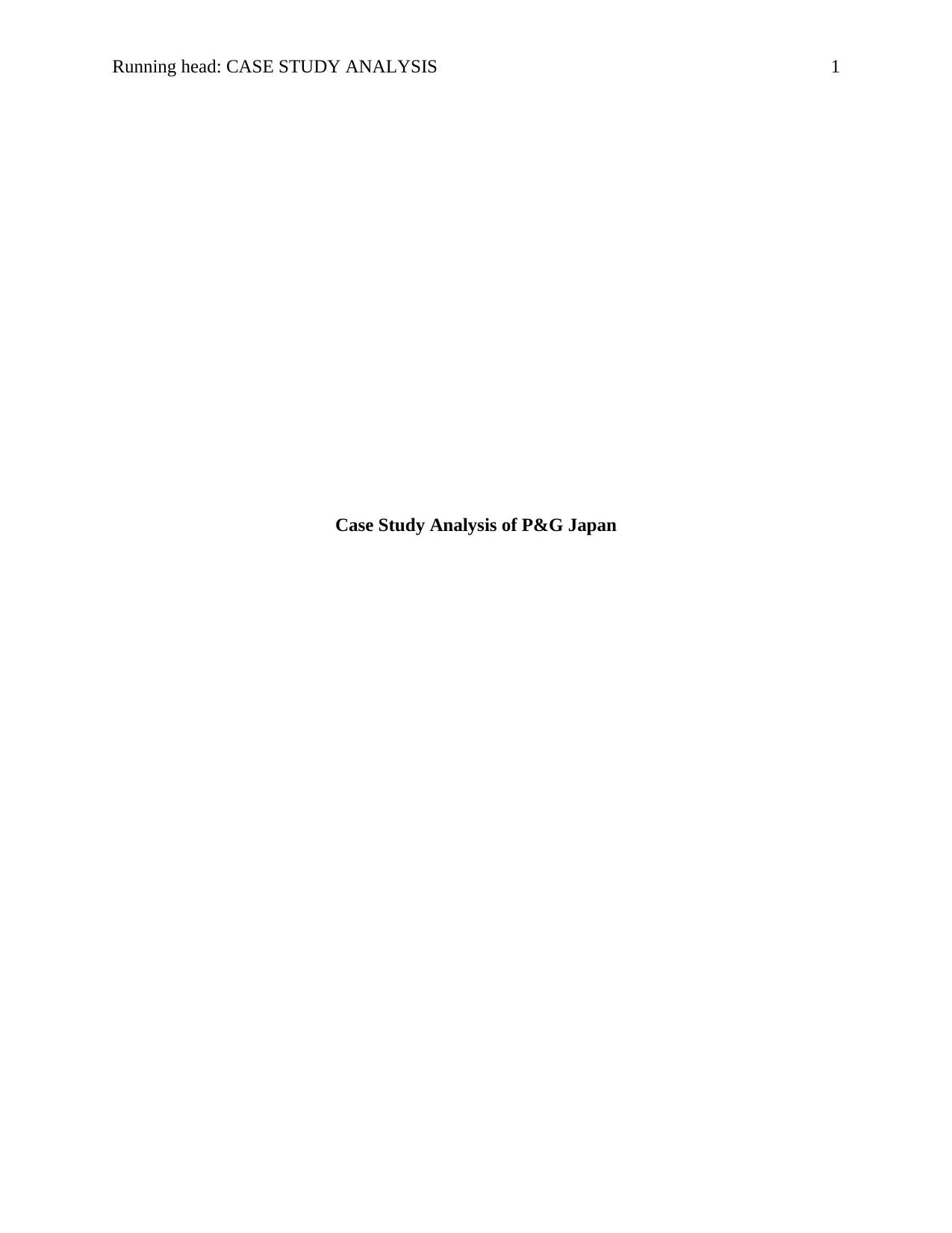
Running head: CASE STUDY ANALYSIS 1
Case Study Analysis of P&G Japan
Case Study Analysis of P&G Japan
Paraphrase This Document
Need a fresh take? Get an instant paraphrase of this document with our AI Paraphraser
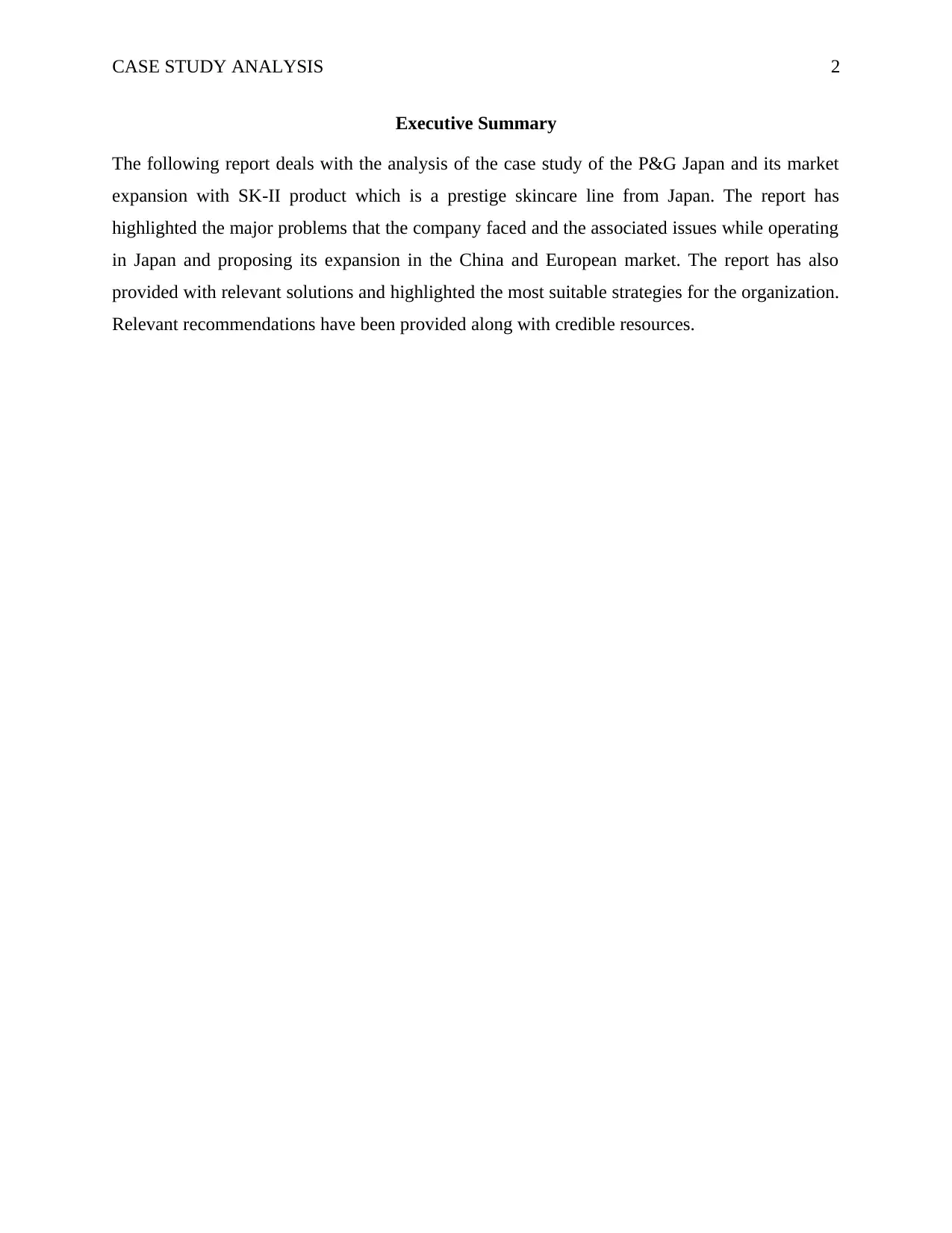
CASE STUDY ANALYSIS 2
Executive Summary
The following report deals with the analysis of the case study of the P&G Japan and its market
expansion with SK-II product which is a prestige skincare line from Japan. The report has
highlighted the major problems that the company faced and the associated issues while operating
in Japan and proposing its expansion in the China and European market. The report has also
provided with relevant solutions and highlighted the most suitable strategies for the organization.
Relevant recommendations have been provided along with credible resources.
Executive Summary
The following report deals with the analysis of the case study of the P&G Japan and its market
expansion with SK-II product which is a prestige skincare line from Japan. The report has
highlighted the major problems that the company faced and the associated issues while operating
in Japan and proposing its expansion in the China and European market. The report has also
provided with relevant solutions and highlighted the most suitable strategies for the organization.
Relevant recommendations have been provided along with credible resources.
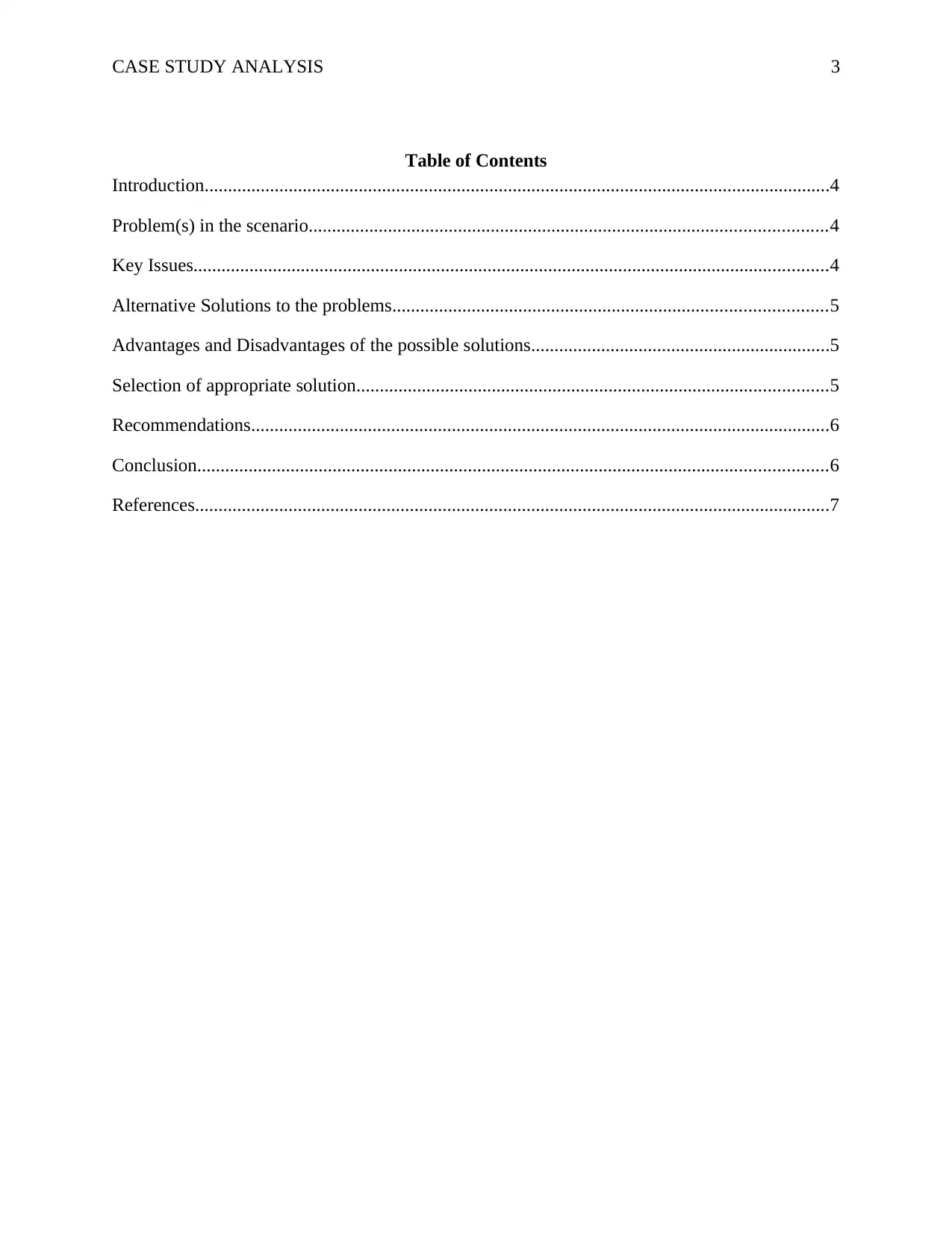
CASE STUDY ANALYSIS 3
Table of Contents
Introduction......................................................................................................................................4
Problem(s) in the scenario...............................................................................................................4
Key Issues........................................................................................................................................4
Alternative Solutions to the problems.............................................................................................5
Advantages and Disadvantages of the possible solutions................................................................5
Selection of appropriate solution.....................................................................................................5
Recommendations............................................................................................................................6
Conclusion.......................................................................................................................................6
References........................................................................................................................................7
Table of Contents
Introduction......................................................................................................................................4
Problem(s) in the scenario...............................................................................................................4
Key Issues........................................................................................................................................4
Alternative Solutions to the problems.............................................................................................5
Advantages and Disadvantages of the possible solutions................................................................5
Selection of appropriate solution.....................................................................................................5
Recommendations............................................................................................................................6
Conclusion.......................................................................................................................................6
References........................................................................................................................................7
⊘ This is a preview!⊘
Do you want full access?
Subscribe today to unlock all pages.

Trusted by 1+ million students worldwide

CASE STUDY ANALYSIS 4
Introduction
According to Taiwo, Agwu & Benson (2016), growth and expansion are two most
important goals of every established business or entrepreneurs. As opined by Wirtz, Tuzovic &
Ehret (2015), Globalization has provided businesses with an opportunity to propel brand
awareness, boost sales and establish markets in new economies. In this following, the case study
of P&G Japan’s global expansion is required to be analyzed, identify its issues and provide
appropriate solutions.
Problem(s) in the scenario
As identified in the case study by Bartlett (2004), P&G Japan proposed an expansion plan
for SK-II, its prestige skincare line from Japan and increase its brand awareness on a global
platform. Moreover, P&G Japan was struggling from its initial stages of international growth
which lead to stagnant growth and profitability. The global expansion was causing problems with
regards to radical change in the market, changing culture, change in process, change in
organizational structure and need for innovation. However, the two most important problems
identified in the case of P&G Japan by Bartlett (2004) are the technical knowledge of the local
regions and dominance of local subsidiaries that did not entertain global products and technology
within the country. As a result, SK-II could have taken several years to enter into the Chinese
and European market. The problems also signaled that Japan had an established cosmetics
market and therefore, P&G Japan was unable to survive in the new category of beauty care and
the situation was much worse.
Key Issues
The key issues identify in the case study highlights the fact that market expansion
requires an organization to consider its target audience, leveraging channels to reach out the
customers, knowledge of the local market, and policies of the local region. As per the case study
Bartlett (2004), P&G Japan was struggling to boost its sales volume and operate in the market.
This was due to lack of knowledge of the local market which suggested that P&G failed to
understand the distinctive needs and habits of the Japanese customer (Danziger, 2017). The
company also faced the issue of cultural change which led to sluggish growth. However, the
Introduction
According to Taiwo, Agwu & Benson (2016), growth and expansion are two most
important goals of every established business or entrepreneurs. As opined by Wirtz, Tuzovic &
Ehret (2015), Globalization has provided businesses with an opportunity to propel brand
awareness, boost sales and establish markets in new economies. In this following, the case study
of P&G Japan’s global expansion is required to be analyzed, identify its issues and provide
appropriate solutions.
Problem(s) in the scenario
As identified in the case study by Bartlett (2004), P&G Japan proposed an expansion plan
for SK-II, its prestige skincare line from Japan and increase its brand awareness on a global
platform. Moreover, P&G Japan was struggling from its initial stages of international growth
which lead to stagnant growth and profitability. The global expansion was causing problems with
regards to radical change in the market, changing culture, change in process, change in
organizational structure and need for innovation. However, the two most important problems
identified in the case of P&G Japan by Bartlett (2004) are the technical knowledge of the local
regions and dominance of local subsidiaries that did not entertain global products and technology
within the country. As a result, SK-II could have taken several years to enter into the Chinese
and European market. The problems also signaled that Japan had an established cosmetics
market and therefore, P&G Japan was unable to survive in the new category of beauty care and
the situation was much worse.
Key Issues
The key issues identify in the case study highlights the fact that market expansion
requires an organization to consider its target audience, leveraging channels to reach out the
customers, knowledge of the local market, and policies of the local region. As per the case study
Bartlett (2004), P&G Japan was struggling to boost its sales volume and operate in the market.
This was due to lack of knowledge of the local market which suggested that P&G failed to
understand the distinctive needs and habits of the Japanese customer (Danziger, 2017). The
company also faced the issue of cultural change which led to sluggish growth. However, the
Paraphrase This Document
Need a fresh take? Get an instant paraphrase of this document with our AI Paraphraser
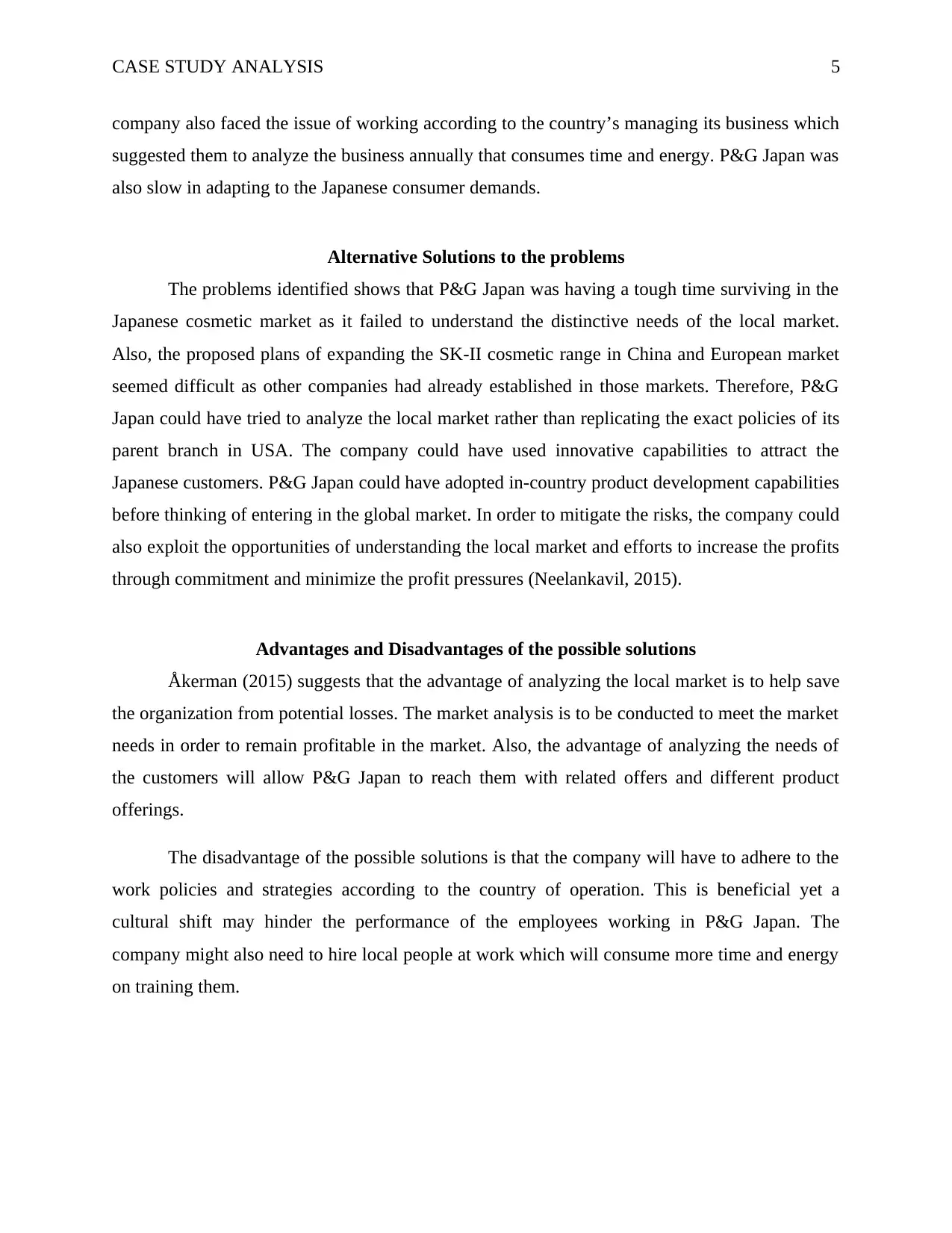
CASE STUDY ANALYSIS 5
company also faced the issue of working according to the country’s managing its business which
suggested them to analyze the business annually that consumes time and energy. P&G Japan was
also slow in adapting to the Japanese consumer demands.
Alternative Solutions to the problems
The problems identified shows that P&G Japan was having a tough time surviving in the
Japanese cosmetic market as it failed to understand the distinctive needs of the local market.
Also, the proposed plans of expanding the SK-II cosmetic range in China and European market
seemed difficult as other companies had already established in those markets. Therefore, P&G
Japan could have tried to analyze the local market rather than replicating the exact policies of its
parent branch in USA. The company could have used innovative capabilities to attract the
Japanese customers. P&G Japan could have adopted in-country product development capabilities
before thinking of entering in the global market. In order to mitigate the risks, the company could
also exploit the opportunities of understanding the local market and efforts to increase the profits
through commitment and minimize the profit pressures (Neelankavil, 2015).
Advantages and Disadvantages of the possible solutions
Åkerman (2015) suggests that the advantage of analyzing the local market is to help save
the organization from potential losses. The market analysis is to be conducted to meet the market
needs in order to remain profitable in the market. Also, the advantage of analyzing the needs of
the customers will allow P&G Japan to reach them with related offers and different product
offerings.
The disadvantage of the possible solutions is that the company will have to adhere to the
work policies and strategies according to the country of operation. This is beneficial yet a
cultural shift may hinder the performance of the employees working in P&G Japan. The
company might also need to hire local people at work which will consume more time and energy
on training them.
company also faced the issue of working according to the country’s managing its business which
suggested them to analyze the business annually that consumes time and energy. P&G Japan was
also slow in adapting to the Japanese consumer demands.
Alternative Solutions to the problems
The problems identified shows that P&G Japan was having a tough time surviving in the
Japanese cosmetic market as it failed to understand the distinctive needs of the local market.
Also, the proposed plans of expanding the SK-II cosmetic range in China and European market
seemed difficult as other companies had already established in those markets. Therefore, P&G
Japan could have tried to analyze the local market rather than replicating the exact policies of its
parent branch in USA. The company could have used innovative capabilities to attract the
Japanese customers. P&G Japan could have adopted in-country product development capabilities
before thinking of entering in the global market. In order to mitigate the risks, the company could
also exploit the opportunities of understanding the local market and efforts to increase the profits
through commitment and minimize the profit pressures (Neelankavil, 2015).
Advantages and Disadvantages of the possible solutions
Åkerman (2015) suggests that the advantage of analyzing the local market is to help save
the organization from potential losses. The market analysis is to be conducted to meet the market
needs in order to remain profitable in the market. Also, the advantage of analyzing the needs of
the customers will allow P&G Japan to reach them with related offers and different product
offerings.
The disadvantage of the possible solutions is that the company will have to adhere to the
work policies and strategies according to the country of operation. This is beneficial yet a
cultural shift may hinder the performance of the employees working in P&G Japan. The
company might also need to hire local people at work which will consume more time and energy
on training them.
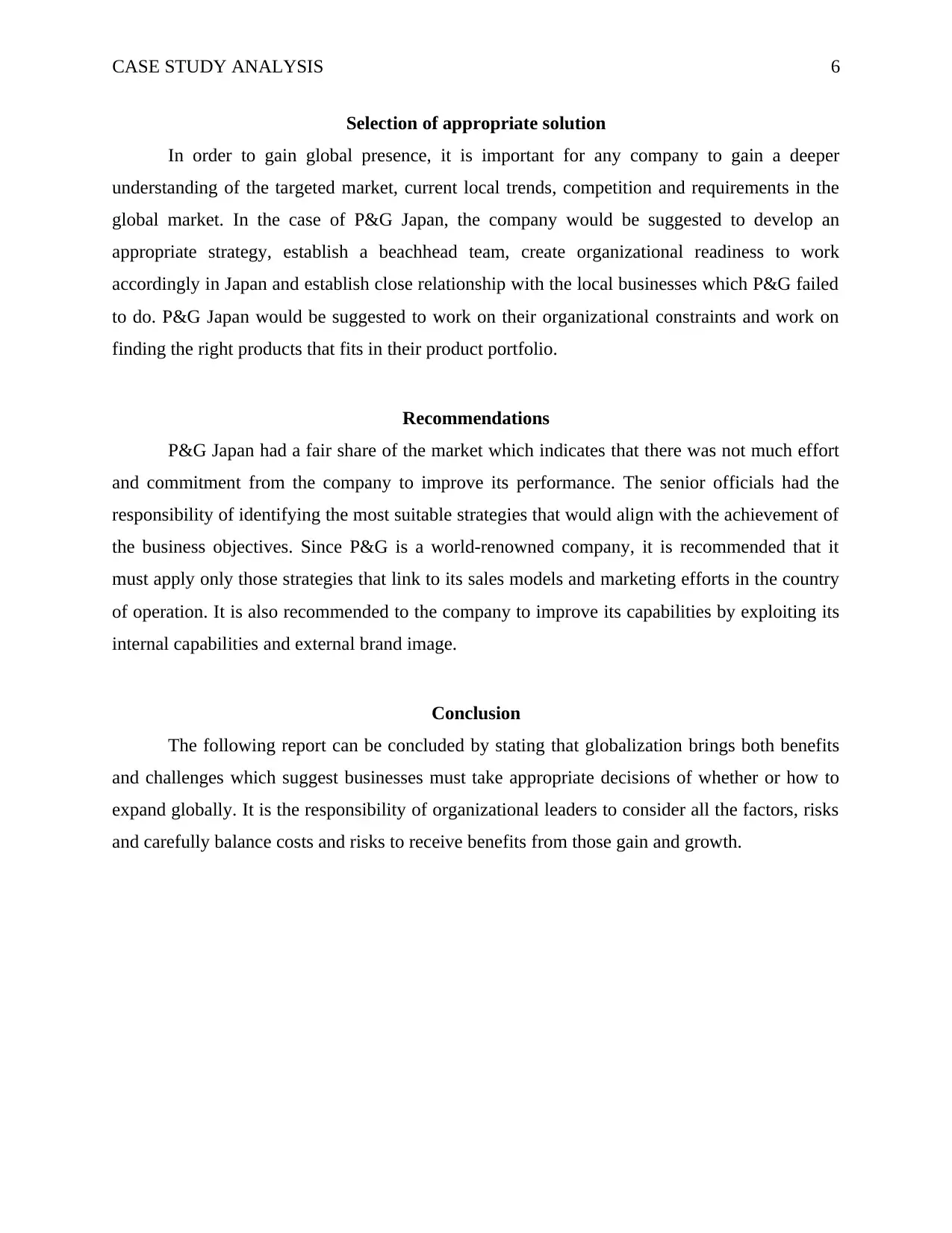
CASE STUDY ANALYSIS 6
Selection of appropriate solution
In order to gain global presence, it is important for any company to gain a deeper
understanding of the targeted market, current local trends, competition and requirements in the
global market. In the case of P&G Japan, the company would be suggested to develop an
appropriate strategy, establish a beachhead team, create organizational readiness to work
accordingly in Japan and establish close relationship with the local businesses which P&G failed
to do. P&G Japan would be suggested to work on their organizational constraints and work on
finding the right products that fits in their product portfolio.
Recommendations
P&G Japan had a fair share of the market which indicates that there was not much effort
and commitment from the company to improve its performance. The senior officials had the
responsibility of identifying the most suitable strategies that would align with the achievement of
the business objectives. Since P&G is a world-renowned company, it is recommended that it
must apply only those strategies that link to its sales models and marketing efforts in the country
of operation. It is also recommended to the company to improve its capabilities by exploiting its
internal capabilities and external brand image.
Conclusion
The following report can be concluded by stating that globalization brings both benefits
and challenges which suggest businesses must take appropriate decisions of whether or how to
expand globally. It is the responsibility of organizational leaders to consider all the factors, risks
and carefully balance costs and risks to receive benefits from those gain and growth.
Selection of appropriate solution
In order to gain global presence, it is important for any company to gain a deeper
understanding of the targeted market, current local trends, competition and requirements in the
global market. In the case of P&G Japan, the company would be suggested to develop an
appropriate strategy, establish a beachhead team, create organizational readiness to work
accordingly in Japan and establish close relationship with the local businesses which P&G failed
to do. P&G Japan would be suggested to work on their organizational constraints and work on
finding the right products that fits in their product portfolio.
Recommendations
P&G Japan had a fair share of the market which indicates that there was not much effort
and commitment from the company to improve its performance. The senior officials had the
responsibility of identifying the most suitable strategies that would align with the achievement of
the business objectives. Since P&G is a world-renowned company, it is recommended that it
must apply only those strategies that link to its sales models and marketing efforts in the country
of operation. It is also recommended to the company to improve its capabilities by exploiting its
internal capabilities and external brand image.
Conclusion
The following report can be concluded by stating that globalization brings both benefits
and challenges which suggest businesses must take appropriate decisions of whether or how to
expand globally. It is the responsibility of organizational leaders to consider all the factors, risks
and carefully balance costs and risks to receive benefits from those gain and growth.
⊘ This is a preview!⊘
Do you want full access?
Subscribe today to unlock all pages.

Trusted by 1+ million students worldwide
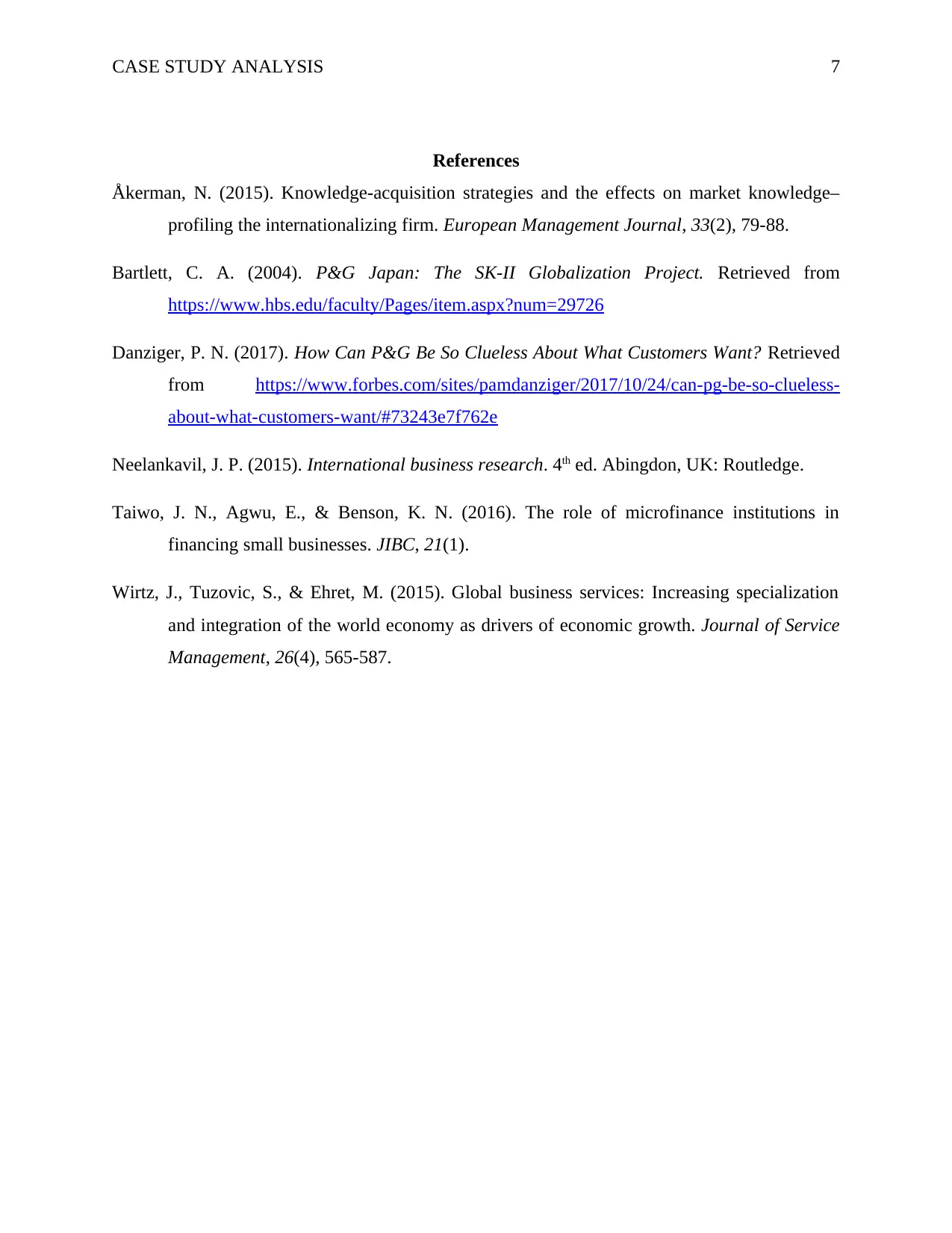
CASE STUDY ANALYSIS 7
References
Åkerman, N. (2015). Knowledge-acquisition strategies and the effects on market knowledge–
profiling the internationalizing firm. European Management Journal, 33(2), 79-88.
Bartlett, C. A. (2004). P&G Japan: The SK-II Globalization Project. Retrieved from
https://www.hbs.edu/faculty/Pages/item.aspx?num=29726
Danziger, P. N. (2017). How Can P&G Be So Clueless About What Customers Want? Retrieved
from https://www.forbes.com/sites/pamdanziger/2017/10/24/can-pg-be-so-clueless-
about-what-customers-want/#73243e7f762e
Neelankavil, J. P. (2015). International business research. 4th ed. Abingdon, UK: Routledge.
Taiwo, J. N., Agwu, E., & Benson, K. N. (2016). The role of microfinance institutions in
financing small businesses. JIBC, 21(1).
Wirtz, J., Tuzovic, S., & Ehret, M. (2015). Global business services: Increasing specialization
and integration of the world economy as drivers of economic growth. Journal of Service
Management, 26(4), 565-587.
References
Åkerman, N. (2015). Knowledge-acquisition strategies and the effects on market knowledge–
profiling the internationalizing firm. European Management Journal, 33(2), 79-88.
Bartlett, C. A. (2004). P&G Japan: The SK-II Globalization Project. Retrieved from
https://www.hbs.edu/faculty/Pages/item.aspx?num=29726
Danziger, P. N. (2017). How Can P&G Be So Clueless About What Customers Want? Retrieved
from https://www.forbes.com/sites/pamdanziger/2017/10/24/can-pg-be-so-clueless-
about-what-customers-want/#73243e7f762e
Neelankavil, J. P. (2015). International business research. 4th ed. Abingdon, UK: Routledge.
Taiwo, J. N., Agwu, E., & Benson, K. N. (2016). The role of microfinance institutions in
financing small businesses. JIBC, 21(1).
Wirtz, J., Tuzovic, S., & Ehret, M. (2015). Global business services: Increasing specialization
and integration of the world economy as drivers of economic growth. Journal of Service
Management, 26(4), 565-587.
1 out of 7
Related Documents
Your All-in-One AI-Powered Toolkit for Academic Success.
+13062052269
info@desklib.com
Available 24*7 on WhatsApp / Email
![[object Object]](/_next/static/media/star-bottom.7253800d.svg)
Unlock your academic potential
Copyright © 2020–2025 A2Z Services. All Rights Reserved. Developed and managed by ZUCOL.



